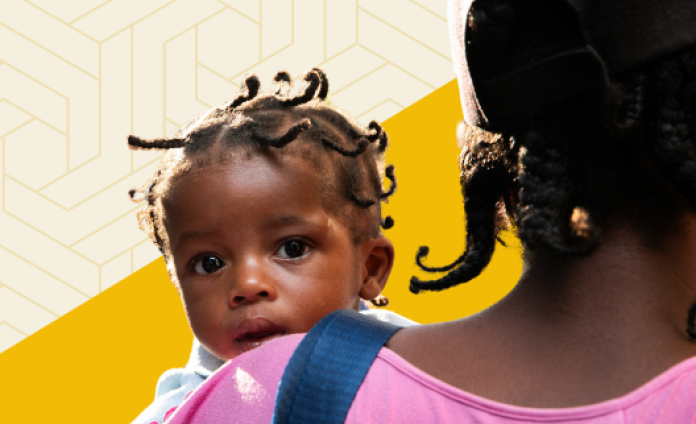
Annual Report 2024
Letter from the President
Dear Friends,
Throughout 2024, with your support, Health Equity International (HEI) kept a path of hope alight for the people we serve.
Together with our supporters, we provided 24/7 lifesaving care for thousands of patients at St. Boniface Hospital (SBH) and the surrounding communities. And together, we helped dozens of vulnerable families in Massachusetts rebuild their lives through our Shelter and Stabilization project.
I am so proud for you to see all we accomplished last year in the following pages. But I would also be remiss if I did not share an important new development that significantly impacts our work going forward.
In early 2025, the U.S. government cancelled our USAID-funded health system strengthening project in Haiti just as it was reaching its midpoint. This decision is profoundly harmful to the people this project served. And it has resulted in a funding gap that threatens the future of SBH.
We have included more information about this situation in the Kore Sante section of this report. But I want you to know that we are working around the clock with our staff and partners to close the funding gap and ensure SBH remains open and fully operational for every patient in need. I also want you to know that while this is the first time we have faced such a threat to our existence, we are not giving way to despair.
We have faced seemingly insurmountable challenges every year for the past several years. And yet we keep moving mountains because we reject despair. We are guided by compassion and the deepest respect for humanity and personhood. And we will never give up on the people we serve, no matter what.
These will always be our core values, and they will always light a path of hope leading us forward.
Kenbe fèm,


What We Do
Health Equity International (HEI) has been providing essential health and support services to those in need for more than 40 years.

Relene safely delivered her third child, Gabensky, at SBH.
SBH is the largest healthcare provider in southern Haiti, offering dozens of clinical services designed to meet our patients’ unique needs. Our doors are always open, and no one is ever turned away because they cannot pay. As a national training hub, SBH helps medical professionals at all career stages learn and grow. And through our community health program, satellite clinic, and health system strengthening efforts, we ensure even the most remote communities have access to quality care whenever they need it.
At HEI, we believe in delivering quality, dignified, compassionate services that help everyone reach their full potential. Together, we’re building a healthier world.
St. Boniface Hospital
2024 By the Numbers
SBH continued to see a high volume of patients across our dozens of services in 2024. Although the humanitarian crisis has made it harder than ever to both access and provide care, our heroic staff worked tirelessly to be there for every patient in need.
132,777
Outpatient visits

8,334
Inpatient admissions

3,497
Births
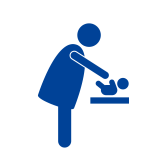
961
NICU admissions
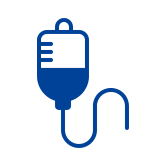
3,856
Surgical procedures
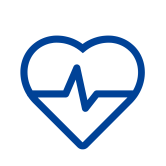
1,409
C-sections

6,584
Emergency room visits

93
Young medical professionals trained
Patient Care
Maternal, Neonatal, and Child Health
Helping Mothers, Reducing Risks
In 2024, 88% of the women who delivered at SBH came from outside our catchment area. Half of all women who delivered had a high-risk pregnancy and 37% of all deliveries had a complication such as obstructed labor or eclampsia, a dangerous elevation in blood pressure.
These figures are the highest rates of high-risk pregnancies and delivery complications ever recorded at SBH. Although many complex factors contribute to these trends, Haiti’s humanitarian crisis has disproportionately impacted pregnant women by making it harder—and sometimes impossible—to access the prenatal care they need.
Our maternal health team went to great lengths to help patients have the safest and healthiest pregnancies possible, including providing over 1,700 home visits for pregnant women in the communities we serve and telehealth appointments via WhatsApp.
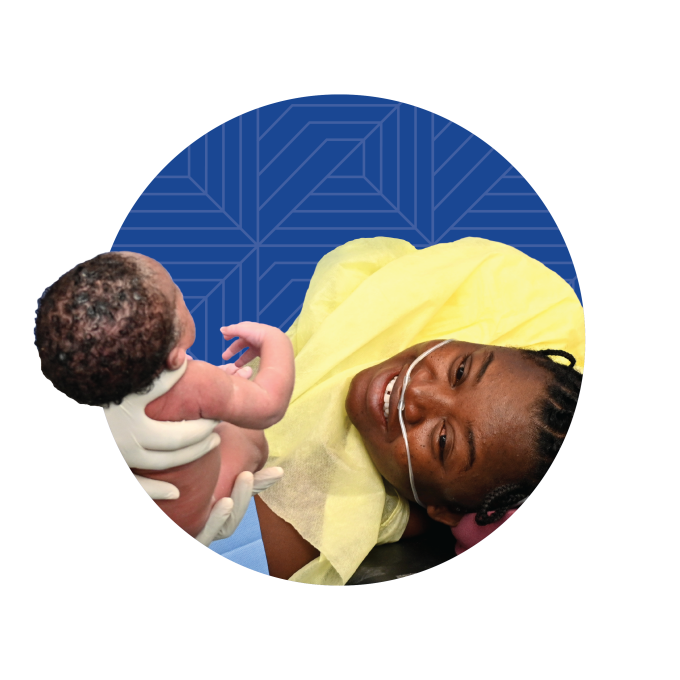
For Shell Simon, these services helped her finally deliver the healthy baby she longed for.
When Shell arrived at St. Boniface Hospital in September 2023, she was unexpectedly pregnant. After five years of heartbreaking miscarriages, Shell and her husband had already given up hope. They couldn’t bear another loss.
But SBH’s OB/GYN, Dr. Berthony Guerrier, was determined to help.
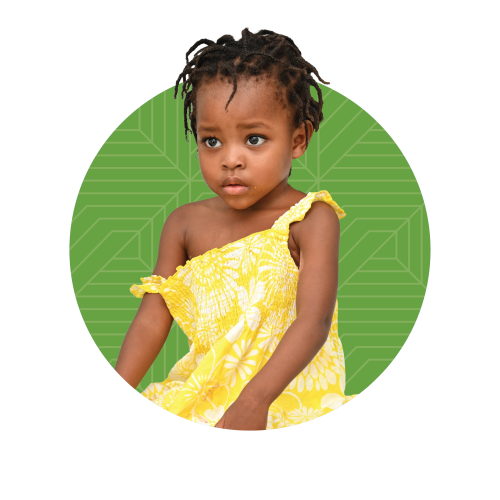
“Thank you to all the SBH staff and especially all of the donors and the surgery staff. Without them, Mackenchina could have gotten worse or even lost her life.” - Ela, Mackenchina’s grandmother
Caring for Young Patients
SBH’s pediatric department had 432 admissions in 2024, 73% of which were children under 5 years old. We also saw 10,704 pediatric visits in our outpatient clinic for everything from routine screenings and tests to support for chronic illnesses like diabetes.
“There is no better place than SBH for a person to find care,” says Ela Beauvil. She watched over her beloved granddaughter Mackenchina for nearly a month as she recovered in our pediatrics ward.
The four-year-old was at home when she tripped on a broom and toppled over a large pot of boiling water, severely burning most of her torso. Ela rushed her to a nearby hospital, but they did not have the resources to provide the care Mackenchina needed. Instead, the pair were sent to SBH. After our emergency care team evaluated Mackenchina, she received emergency surgery to treat her injuries. She then spent several weeks recovering under the watchful eyes of our pediatrics team, ensuring her wounds healed and no infection developed.
“Mackenchina wasn’t only in a hospital, but in the midst of a family,” says Ela. “The nurses and the doctors appreciated her and were patient in giving her care up until the moment she returned home.”
Continuously Improving Neonatal Care
SBH’s neonatal intensive care unit (NICU) was busy all year with a total of 961 admissions to our world-class facility. Our attentive staff often managed 35-45 babies per day: an extraordinarily high volume of infants in need of life-saving care.
Our NICU staff must constantly stay abreast of best practices to help our youngest patients grow healthy and strong. Throughout the year, NICU staff participated in refresher trainings on neonatal resuscitation, infection control measures, and the importance of neonatal blood tests to help prevent sepsis.
Staff also conduct health education sessions for mothers and caregivers with infants in the NICU. These sessions cover topics including breastfeeding support, vaccine schedules, and the warning signs of illness. With support from our dedicated team, families can feel more confident protecting their newborn’s health long after they leave the NICU.
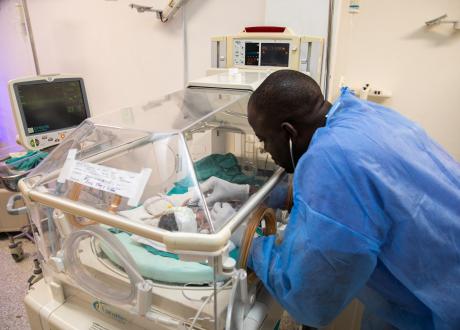
Checking an infant’s breathing and heartbeat.

Connecting with parents is an important part of NICU care.
Infectious Disease
Care for Complex Diseases
Hilaire is one 157 patients admitted to our one-of-a-kind Infectious Disease Center for treatment in 2024. She was diagnosed with tuberculosis (TB), a highly contagious bacterial infection that most commonly affects the lungs.
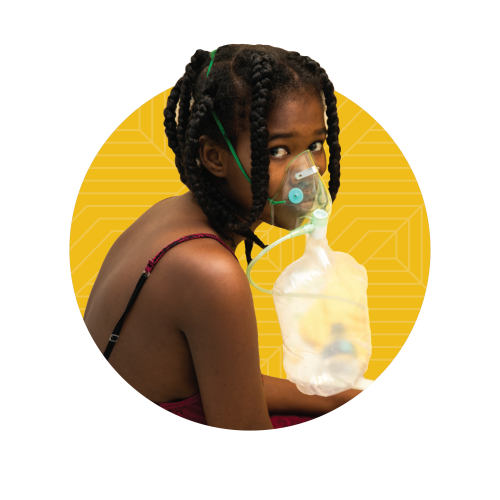
Medical-grade oxygen helps Hilaire breathe more easily during her stay at SBH.
Although complete recovery from TB takes months of strict adherence to a multi-drug treatment regimen, our dedicated staff worked hard to accompany more than 100 patients like Hilaire on the long road to good health— even hand-delivering medication to patients’ homes when traveling to the hospital was too difficult for them.
But we don’t just treat TB. In 2024, our Infectious Disease Center staff also treated 29 cases of malaria, 12 suspected cases of cholera, and 8 cases of tetanus.
Our community health team complimented this work by distributing mosquito nets and teaching people how to reduce the spread of infectious diseases. Education sessions about reducing pools of stagnant water where mosquitoes can breed, or the importance of hand hygiene, help our community members protect themselves and those around them.
Screening for Cervical Cancer in HIV+ Women
A cross-departmental team at SBH led a new initiative to routinely screen HIV+ women for cervical cancer.
Cervical cancer is the second most deadly cancer for women in Haiti. However, screening for cervical cancer is difficult for many hospitals, including SBH, largely due to countrywide lack of resources and laboratory testing capabilities. But despite the challenges, we knew we had to figure out a way to begin delivering this essential service for patients at high risk.
For the program’s pilot, we screened 106 HIV+ women aged 20-60 enrolled in our HIV/ AIDS program. While the majority of results were normal, 22 patients had lesions that needed to be biopsied and seven patients required hysterectomies. Thanks to these screenings, we were able to bring these 29 patients to SBH for the care they needed. The final group of screenings from this cohort is awaiting testing in Port-au-Prince. As soon as there is a window in the security situation to transport these tests, we will complete the process and continue this crucial program for patients in need.
Emergency Care
There For Every Patient
SBH’s Emergency Care Center is in constant motion. As the only 24/7 facility of its kind in southern Haiti, our highly skilled emergency medicine specialists receive patients of all ages at all hours of the day. In total, our team saw 6,584 visits in 2024 for conditions ranging from severe injuries to acute complications from diabetes.
One of the biggest challenges the ER team faced in 2024 was the overwhelming demand for care. Wait times began to increase because every bed was constantly full. Because many ER patients are admitted to the internal medicine department for inpatient care, the two teams worked closely together to improve patient flow. The ER team has also been looking to increase their capacity to assess more patients more quickly, especially for low-acuity cases. “Good interpersonal communication can reduce the reaction time to solve challenges in time and better coordinate the care chain,” says Head ER Nurse Geneviève Edumé. “Solidarity, team spirit, dedication, and empathy are the essential points of a good team.”

Dozens of clinicians and support staff filled the ER to care for victims of the explosion.
Urgent Care After an Explosion
On September 14, 2024, a fuel tanker exploded in the town of Miragoâne, just 20 miles from SBH.
We immediately activated our emergency response protocols. Staff began setting up triage areas, preparing space for the injured, and pulling wound care supplies and medications from our warehouse stock. Doctors, nurses, social workers, cleaners, ambulance drivers, and support staff all jumped in to help—whether or not they were on duty that day.
In under two hours, we were caring for 24 patients, many with burns covering more than 50% of their bodies. We also worked closely with Haiti’s Ministry of Health to safely transfer the most severely injured patients to a specialized burn center. Together, our heroic staff worked to stabilize survivors, soothe their pain, and support their family members.
Surgery
Reliable Emergency Procedures
A 2015 study estimated that only 11% of healthcare facilities in Haiti had the capacity to perform surgeries. Since then, a cascading series of crises forced many hospitals to shutter—making it even harder for patients to access life-saving medical procedures.
Although the crises have put enormous strain on our staff and supplies, our surgical program has endured. In 2024, we performed a total of 3,856 surgeries—more than half of which were emergency procedures.
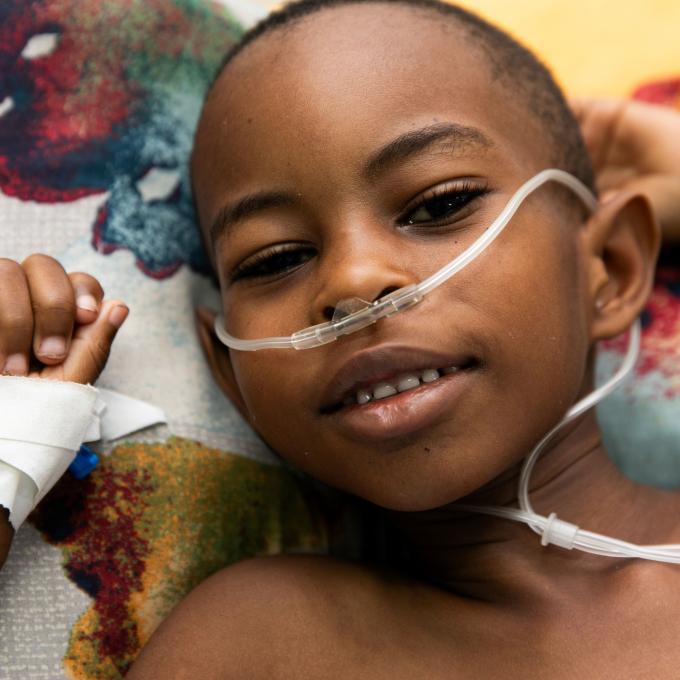
Six-year-old Ganaël was one of these emergencies.
“It started off with a minor fever,” says Ganaël’s mother, Linda. “As the days went by, the fever rose and he began to have breathing problems. We took him to a private hospital in Petit Goâve. The doctors there told me that he had a lung infection and they gave him medication. But the medication did not work.”

Advanced Surgical Care
SBH began an orthopedic surgery program in response to the devastating 2021 earthquake in southern Haiti. Since then, we’ve performed more than 1,000 of these highly specialized procedures, including 275 procedures in 2024 for patients like Mona.
“While I was in Fonds-des-Nègres to buy produce for trading, a vehicle ran over my foot,” says Mona. “I had to go to the ER in Fond des Blancs so as not to lose my foot.”
Spinal Cord Injury Rehabilitation
One Step at a Time
“I always say, next to God’s grace, it’s the therapy that got me walking again,” says 36-year-old Cherline, who has battled Guillain-Barré syndrome for more than two years. This rare autoimmune disease attacks the peripheral nerves, and it was devastating for Cherline.
Cherline is one of nearly 800 patients who received services at our rehabilitation center in 2024. This center is part of our Spinal Cord Injury Program, a one-of-a-kind service providing long-term care and critical wraparound services for those recovering from severe illness or injury.
In 2024, physical therapist Rose Milord Celestin and our SCI team provided 1,857 inpatient physical therapy sessions and 1,394 outpatient sessions, helping patients like Cherline reclaim their mobility and independence.

Before coming to SBH, Cherline visited two other hospitals without improvement. She says, “When I came to [SBH], I was in the emergency room first. Then the ER sent me to see internists, and that’s when I started to do therapy. I was not well at all.”

Rony in his new wheelchair
Keeping the Wheels Turning
Many of our SCI patients depend on wheelchairs to get around. While these essential assistive devices can greatly improve beneficiaries’ quality of life, Haiti’s rough, rocky terrain can take a serious toll on them. Thanks to partnerships with organizations like Hope Health Action, we’ve been able to distribute 88 new wheelchairs and assistive devices to those in need.
Rony became paraplegic after falling from a tree. Although he had a wheelchair, it did not fit him and was becoming more difficult to use over time. The problem became so severe that Rony would frequently fall out of the chair while going to church, or even just getting around the house.
Our SCI team knew he deserved better. So, we fitted Rony for a new chair that keeps him comfortable and secure. Now, Rony can get around the house, go to church, and participate more fully in life with his wife, children, and nephew.
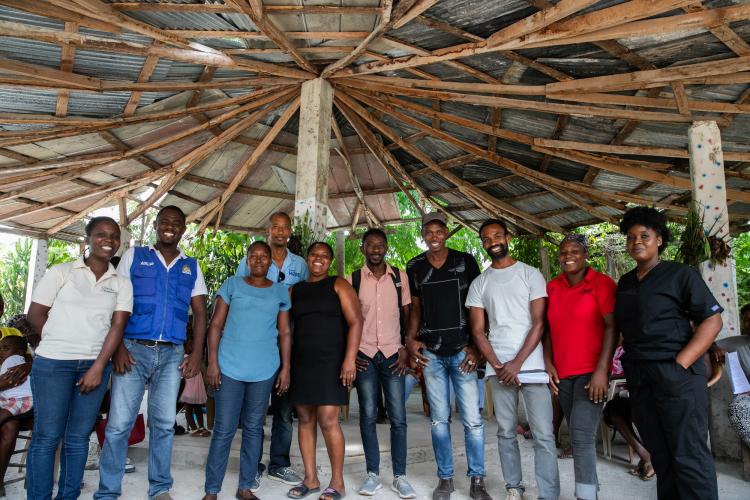
Peer leaders and SBH community health workers gather for a group photo after leading a Ti Fwaye session.
Community Health
Always on the Move
SBH’s community health program keeps thousands of people in our catchment area connected to care. This work is more important than ever during this time of crisis when traveling to any hospital for care can be dangerous. Here’s a breakdown of just a few of our most critical community-level activities:
543 Rally Posts
where community health workers (CHWs) provided 11,417 childhood vaccines, 1,744 diphtheria vaccines for pregnant women, 14,242 pediatric malnutrition screenings, 9,918 doses of vitamin A and iron supplements for children and pregnant women, and more.
3,630 Community Education Sessions
on key topics such as hand hygiene, malaria prevention, family planning, nutrition, and social inclusion of people living with HIV/AIDS and disabilities.
11,636 Home Visits
for vulnerable members of the community who need ongoing care but cannot travel frequently to SBH. Through this service, we can provide pregnant women, people living with HIV/AIDS and/or disabilities, and other patients in need with medication refills, checkups, repairs and adjustments for assistive devices, and more.
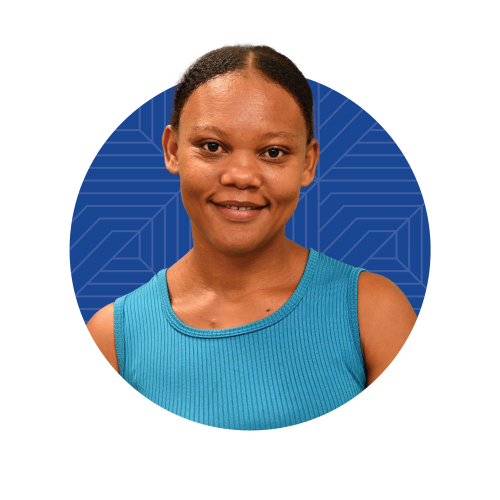
Jonette, Ti Fwaye peer educator
Neighbors Helping Neighbors
During a visit to the community of Bellegarde, CHWs noticed Jonette’s children were thriving even though pediatric malnutrition was common in the area. So, they invited Jonette to join Ti Fwaye (“little hearth”): a program where caregivers of well-nourished children help teach good cooking and nutrition practices to caregivers of malnourished children.
Jonette was excited and eagerly came to SBH for training on how to facilitate Ti Fwaye sessions. Soon, she was ready to begin leading two-week sessions together with our CHWs. With each session, Jonette felt a growing sense of fulfillment. “I am always proud to instruct the mothers and provide my support to help them with their children,” she says. “Not only did I learn a lot myself, I also learned how to help other people and help those close to me.”
Throughout 2024, Jonette and her fellow peer leaders held a total of 18 two-week trainings for 278 mothers and pregnant women and 284 children in dozens of communities surrounding SBH.
In 2024, we assessed the immediate and long-term impact of Ti Fwaye by tracking the weight and mid-upper arm circumference (MUAC) of 63 children at the program’s start, four months later, and again at 12 months. Every child gained weight over the year, and 95% saw an increase in MUAC, showing that families continued applying what they learned to support steady, healthy growth. We are incredibly proud of each participant and peer leaders like Jonette, who are helping children thrive.

Jaden Mwen participants receive seedlings to take home.
Growing Stronger
Jaden Mwen (“my garden”) is another way we are nourishing the communities we serve. The crises in Haiti and the impacts of climate change have made accessing nutritious food in Haiti harder than ever, which is contributing to an increase in malnutrition rates.
To help combat this trend, we began teaching women how to grow their own fresh produce. In addition to feeding their families, Jaden Mwen also helps women generate their own income, since they can sell any surplus produce in the local markets.
In 2024, we held 8 Jaden Mwen sessions for 119 women. Pepper, eggplant, and onion seedlings were grown in nursery sites, where participants learned to nurture them. Once large enough to transplant, the seedlings were distributed to participants and replanted at their homes. With careful tending, participants grew abundant harvests.
Training and Capacity Building
A Stronger Medical Workforce
SBH is one of the most sought-after training sites for medical residents in Haiti.
In 2024, we were honored to host 24 social service doctors and 29 social service nurses for the year. These residents had just completed their formal medical training and needed to complete a mandated year of “social service” in a Ministry of Health-affiliated hospital. At SBH, they rotate through each service to get hands-on experience with every kind of care we provide our patients.
We also hosted 30 specialty residents, who completed their social service year and wish to continue their training in a specific area of medicine such as surgery, maternal, neonatal, and child health, or emergency medicine. Specialty residents spend approximately one month at SBH before leaving to train at other hospitals across Haiti.
Finally, we welcome a number of “pre-interns” each year. These trainees are in their last year of medical school and are combining classroom instruction with in-hospital practice.
“When I arrived at SBH, I said that every [geographic department in Haiti] should have a facility like this,” says pre-intern Marie Christ Love Robergeau.
Because we never turn patients away, residents and interns like Marie see a greater range of cases than they would at most other healthcare facilities. When they leave SBH, they take the skills they’ve learned to other hospitals—elevating the level of care provided throughout the country.
“Compared to all other hospitals,” says Marie, “SBH is the only hospital that makes a difference in the way they provide care. It is a hospital where you can come without any worries, the staff provides care with heart, and those who are considering internships can come because they’ll receive good quality training.”
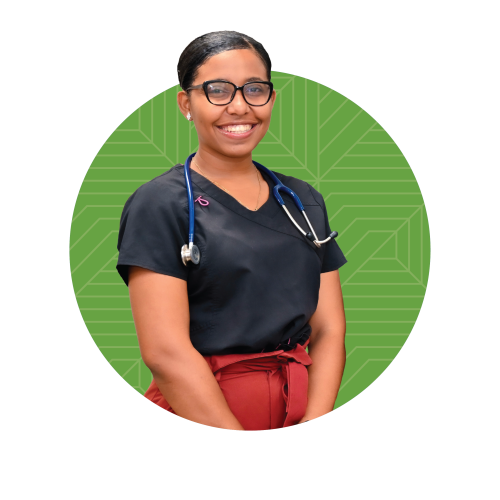
“Compared to all other hospitals, SBH is the only hospital that makes a difference in the way they provide care.
Marie Christ Love Robergeau, pre-intern
Equipment Check
For nearly 10 years, the REPARE (Reparasyon Pou Amelyore Ekipman Medikal) program has helped hospitals in Haiti keep medical equipment running smoothly. Through routine maintenance and expert repairs, REPARE-trained technicians ensure clinicians always have the tools they need to save lives.
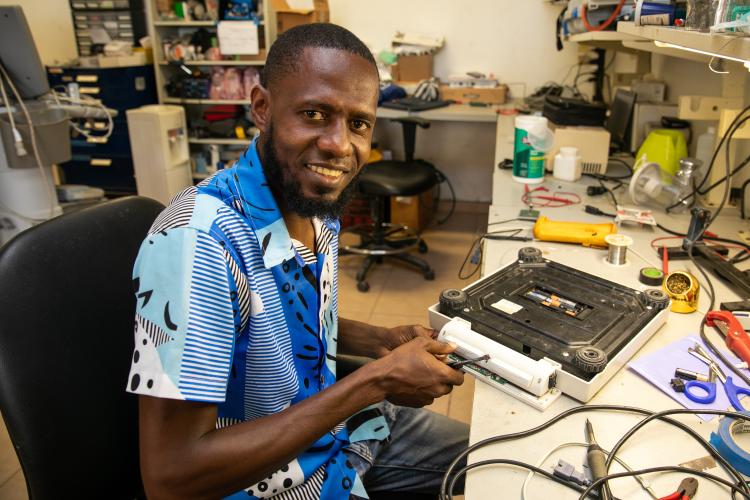
Alix works on a project in the REPARE workshop.
Alix Ilophene, SBH’s chief biomedical engineering officer, had a busy year. While repairing vital monitors, ECG machines, and incubators, maintaining oxygen concentrators and autoclaves, and installing new medical equipment, he still made time to help others.
In August, Alix twice traveled four hours each way to Centre de Santé Lumière in Les Cayes to repair anesthesia machines—essential equipment for performing surgeries. He also provided remote support for repairs at Hôpital Georges Gauvin in Grand Goâve and made the difficult journey to SBH’s satellite clinic in Villa to service a range of critical equipment, from infant warmers to oxygen concentrators.
For Alix, supporting other hospitals is one of the most important parts of his job. He says, “In order to help the Haitian health system run better, in order to help hospitals to have equipment that is always operational and ready to serve patients, in order to help medical personnel continue to heal and save lives, it is very important that we help other hospitals.”
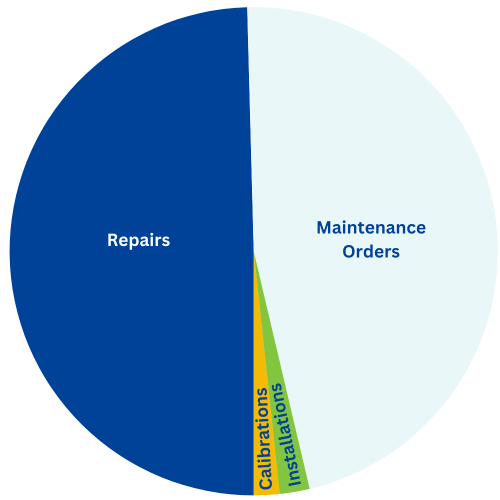
REPARE’s Work in 2024
175 Repairs
Equipment repairs restore broken equipment to good working order.
165 Maintenance Orders
Cleaning and other routine maintenance helps increase the longevity of biomedical equipment and prevents breakdown.
7 Installations
Correctly installing new equipment takes time and expertise.
6 Calibrations
Equipment calibration helps ensure accurate measurements and proper recording of data.
Improving our Solar Grid
Southern Haiti doesn’t have an electricity grid; instead, electricity comes from diesel-powered generators or, more rarely, from solar panels. SBH has been using both for many years to power the hospital and serve as backup systems for one another.
However, the crisis in Haiti has made it difficult to find the fuel we need for the generators. When fuel can be found, it is exorbitantly expensive. To ensure we are never without the power we need, we realized we needed to decrease our reliance on generators and increase our solar capacity.
Throughout 2024 we worked with Build Health International (BHI) to create a new 748-panel solar field next to the hospital. Combined with the existing 780 solar panels on the roof of SBH, we will be able to generate up to 553 kilowatt peak (kWp) once the project is completed: enough power to offset a significant portion of our generator usage.
Thanks to our hardworking operations team and our good friends at BHI, we’re ensuring we are never without the power to provide lifesaving care to anyone in need.
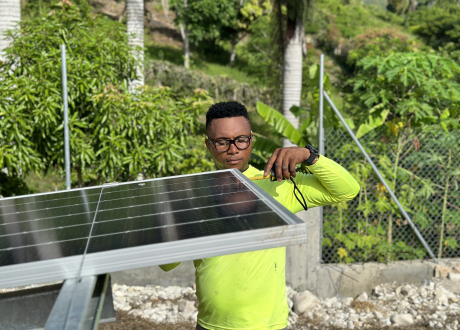
Installing a solar panel.
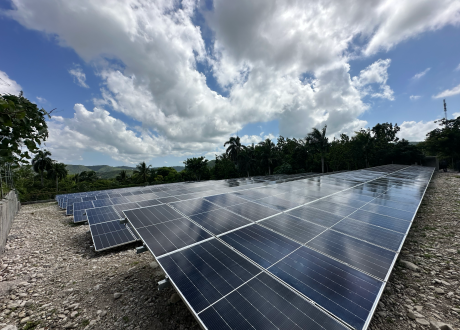
SBH’s new solar panel field under a beautiful blue sky.
Kore Sante
An Exemplary Project, A Shocking Loss
The Improved Health Service Delivery (IHSD)/Kore Sante (“Supporting Health”) project was a 5-year, USAID-funded health system strengthening program. In southern Haiti, HEI had been leading the program since 2022, helping seven nongovernmental organizations and 31 public and private healthcare facilities improve the quality of care they provide to hundreds of thousands of patients.
In early 2025, the U.S. government terminated our contract at its midpoint, even though Kore Sante was doing everything right in an extraordinarily challenging environment.
The sudden and shocking loss of funding has immediate and dangerous repercussions for our patients, our partners, and also SBH. We fear many IHSD-affiliated health facilities will have to lay off staff, will struggle to source and purchase resources, and may ultimately be forced to close. This situation has also caused a significant funding gap at SBH that may lead to cuts in critical medical services if left unfilled.
The funding SBH received through the IHSD program helped us meet the unprecedented demand for care. It was also absolutely critical to helping us manage the skyrocketing costs of procuring and transporting the essential medicines and supplies we need to care for hundreds of patients every single day.
We are doing everything in our power to ensure SBH remains fully operational for every patient in need. We also remain committed to sharing knowledge, resources, and training opportunities with our IHSD community whenever possible.
At the same time, we want to take a moment to celebrate what this remarkable program accomplished in just two years. In the following section, you will learn how HEI, SBH, and our partners provided quality, dignified care to thousands of patients both at healthcare facilities and within remote communities across southern Haiti. From safely delivering babies to helping people living with HIV achieve viral suppression, we made great strides in creating a stronger and more stable health system in the region.
The IHSD Program had a tremendous impact in just two years:
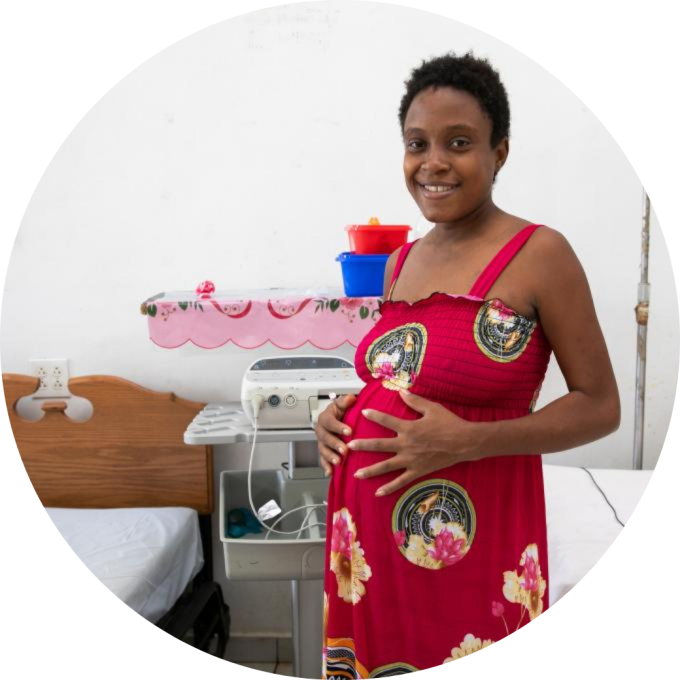
Maternal Health
23,270 pregnant women completed at least 1 prenatal care visit
19,349 mothers and newborns visited within 3 days of birth
Family planning services integrated into routine healthcare
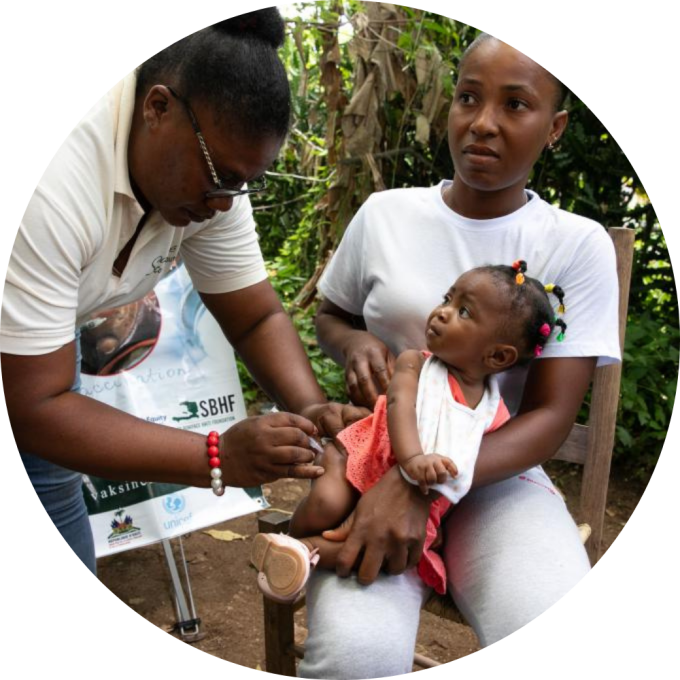
Childhood Health
98,358 children under 5 years old reached by nutrition programs
3,907 children treated for moderate and severe malnutrition
17,071 babies fully vaccinated by 12 months old
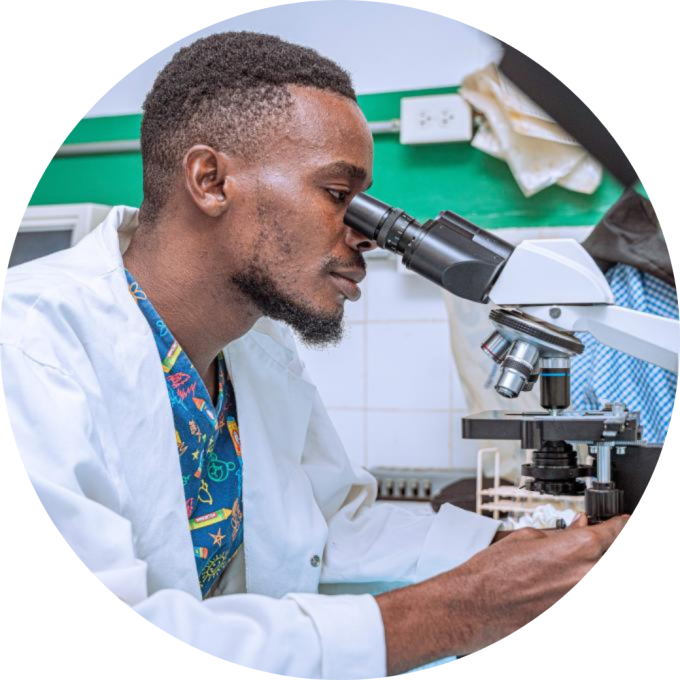
HIV Epidemic Control
2,507 people living with HIV receiving antiretroviral treatment, 85% with suppressed viral loads
28,910 people tested for HIV, with 671 positive test results
96% of pregnant women tested for HIV at their first prenatal visit
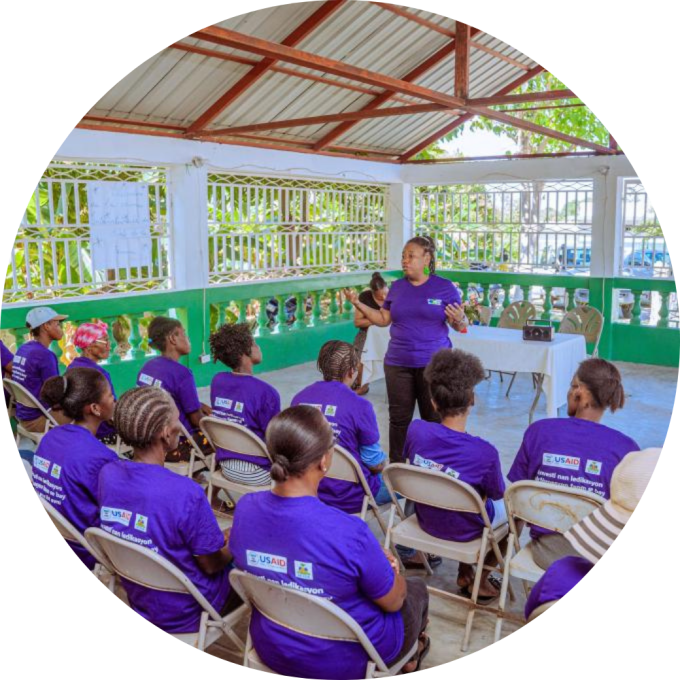
Addressing Gender-Based Violence
Trained 3,000+ community leaders and health workers to respond to gender-based violence
Organized events across the region to mark the International Days for Women’s Rights and the Elimination of Violence Against Women

Water, Sanitation, and Hygiene
7,000+ Tippy Taps installed to improve handwashing while conserving water
Thousands of sanitation and hygiene kits distributed to schools, churches, community centers, and individual households
100% of health facilities trained on infection prevention and control

Management
Distributed essential medicines and supplies; trained 35 stock managers
Helped facilities develop disaster plans and hold simulation exercises
5 partners and 12 health facilities created organizational development plans
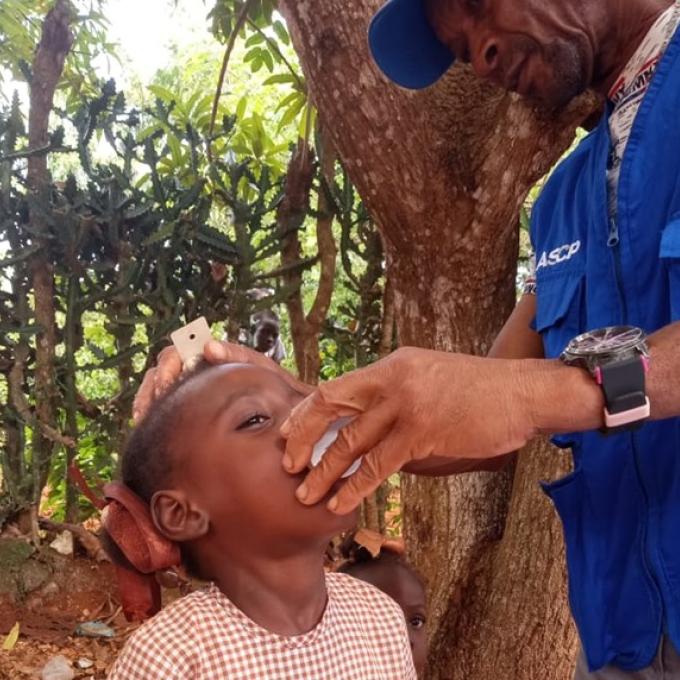
Improving Children’s Health
Vitamin A is essential for immune system functioning and children’s growth. Yet vitamin A deficiency is widespread in more than half of all countries—including Haiti— where it contributes to childhood infections and blindness.
Fortunately, UNICEF has found that periodically providing children with high-dose vitamin A supplements reduces childhood mortality by 12-24%. So last spring, our Kore Sante team led a two-pronged campaign to promote vitamin A within the communities we serve.
Shelter and Stabilization
HEI began partnering with the State of Massachusetts in May 2024 to provide shelter and stabilization services for unhoused migrant families. The current iteration of our shelter and stabilization program will come to an end in June 2025, as the State’s needs have evolved. We are currently working with our friends and partners to determine how we can best continue to support this population.
Our program provides safe shelter to families of all backgrounds along with support services to help them achieve self-sufficiency and live independently. We work in accompaniment with each family to design an achievable rehousing and stabilization plan that meets their unique needs and moves them toward the future they want for themselves.
In addition to emergency shelter, our slate of wraparound services focus on helping clients secure appropriate housing, generate sustainable income, enroll their children in school, obtain adequate food and medical care, and access other necessities all people need and deserve to live stable and independent lives.
Our initial cohort of clients included 48 families housed in two shelters. To date (May 2025), our hardworking team has helped more than 50% of our adult residents find stable employment, enrolled 100% of our school-aged children in local schools, and helped 19 families transition out of shelter and into their own apartments.
We are proud to have answered the call for help and honored to have helped some of our most vulnerable neighbors rebuild their lives after facing unimaginable hardship.

Building A New Life
“I have never regretted, not for one day, that I came here,” says Jean* as he reflects on his journey from Haiti to Massachusetts. Jean, his wife Marie*, and their two children fled the violence and insecurity in Port-au-Prince seven years ago. They first went to Brazil, where they struggled to find enough work to stay afloat. In search of a better life, the family uprooted themselves again and came to the U.S. in 2023.
Read more about Jean’s experience
* Names changed to protect the clients’ identities.
Back to School Success
“One of our most important responsibilities is making sure the children in our care are enrolled in school and have the support they need to thrive,” says HEI’s Director of Shelter and Stabilization Services Jamila Hussein. “Starting school in a new country can be so hard for kids. We want to help with that transition and make sure our kids have the support they need to be successful.”

HEI staff pose with backpacks they’ve prepared for the kids in our emergency shelters.
In August 2024, we held a back-to-school event to help our kids prepare for their first day. Each child got to pick their own brand-new backpack along with all the supplies they needed—pencils, markers, notebooks, and more. We also set up a water bottle-decorating station, allowing them to get creative and show off their own personal flair.
“We work closely with the teachers, social workers, and staff at the schools to ensure our kids have what they need and fill any of the gaps we find,” says Jamila. “But the most rewarding thing has been to see so many of our children enjoy going to school every day. To see them making friends, learn, do things they’re proud of—it’s just a joy to see.”
Coming Home
Gregg Cothias, HEI’s Assistant Director of Housing and Stabilization, leads a small team focused on moving families out of emergency shelter. He finds apartment listings, calls landlords, and helps both clients and landlords navigate the State’s housing assistance program for families facing homelessness. Because families must be able to make a substantial contribution toward their housing costs, Gregg explains, “Finding employment is the first priority. Then, finding housing that meets their needs.”
Beyond that, the families we serve need assistance understanding unfamiliar systems and a new culture. Gregg says, “At HEI, we really want to support our residents however we can. We’ll help them figure out their finances, and teach them how to do something, so that next time they can handle it on their own.”
Gregg and his team are currently helping an average of four families per month move out of shelter into their own apartments. And even after they’ve moved, HEI is only a phone call away. The families in stabilization maintain a connection to our team and to the families remaining in shelter, and they’re always ready to help others by sharing information on jobs and resources.
“Every single one of them is super-resilient. They’re their own best advocates,” says Gregg. “When clients secure housing, they’re over the moon. It’s extremely rewarding to see them embark on a journey of their own.”
Donor Roll
Fiscal Year 2024 Donors
Generous donors like you made it possible for us to provide life-saving and life-changing health and support programs for the people we serve even amid some of the most difficult and unprecedented challenges we have ever faced. You made a difference for thousands of people.
This list of donors represents individuals and organizations that made contributions during our Fiscal Year 2024 (July 1, 2023- June 30, 2024). Gifts given after the end of our fiscal year will berecognized in our next annual report.
On behalf of all of our staff and patients, thank you.
Financials
HEI ended Fiscal Year 2024 (July 1, 2023-June 30, 2024) in a strong financial position.
Generous funding from our partners and supporters helped us deliver comprehensive, dignified services while strengthening the Haitian health system during another challenging year. Together we launched a shelter and stabilization project, responded to a devastating explosion, navigated complex procurement challenges, and more.
We are deeply grateful to everyone who made this work possible.
Photos by Densi Photography, Gilles Poteau, Nadia Todres, and Jesse Wang.